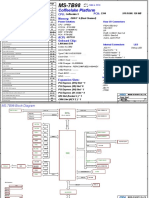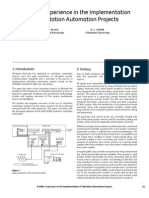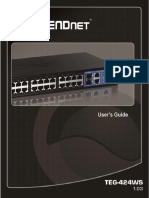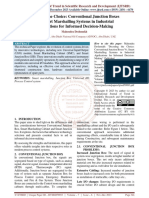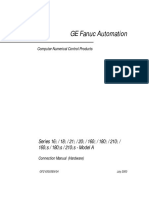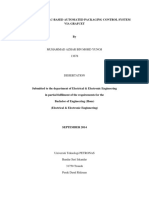Technical White Paper: Intrinsically Safe Fieldbus in Hazardous Areas
Technical White Paper: Intrinsically Safe Fieldbus in Hazardous Areas
Uploaded by
esmat123Copyright:
Available Formats
Technical White Paper: Intrinsically Safe Fieldbus in Hazardous Areas
Technical White Paper: Intrinsically Safe Fieldbus in Hazardous Areas
Uploaded by
esmat123Original Title
Copyright
Available Formats
Share this document
Did you find this document useful?
Is this content inappropriate?
Copyright:
Available Formats
Technical White Paper: Intrinsically Safe Fieldbus in Hazardous Areas
Technical White Paper: Intrinsically Safe Fieldbus in Hazardous Areas
Uploaded by
esmat123Copyright:
Available Formats
TECHNICAL WHITE PAPER INTRINSICALLY SAFE FIELDBUS IN HAZARDOUS AREAS
Decision Guidance for Intrinsically Safe Fieldbus Solutions
Currently different solutions are available for intrinsically safe fieldbus like Entity, FISCO or High-Power Trunk and recently announced redundant FISCO and DART concepts. This paper chronologically accounts the history of all intrinsically safe explosion protection concepts for fieldbus and gives an outlook on DART and the redundant FISCO concepts. The paper then goes on to compare all methods one-on-one with a practical view on their merits and drawbacks. This paper is directed at technical decision makers involved in planning fieldbus topologies for the hazardous area in search of solutions.
28/07/2008 EDM TDOCT-1548_ENG 211701
Prepared by: Armin Beck Product Portfolio Manager Fieldbus Infrastructure Andreas Hennecke Product Marketing Manager Fieldbus Infrastructure
Pepperl+Fuchs is the proven market leader for innovative and highly available components for your fieldbus according to IEC 61158-2. With quality components to fit your process automation system and demands in the field our highly reliable and energy-efficient design allows you to focus on the task at hand. Knowing that your fieldbus is running. The High-Power Trunk Concept with Entity or FISCO devices: Connect the maximum number of devices to the same fieldbus trunk; and at the same time make use of maximum cable lengths. This concept utilizes standard power supplies such as the easy to install and configuration free Power Hub. Segment Protectors and FieldBarriers are installed close to field devices and limit the energy at the spur. You are free to work on field devices without hot work permit. Advanced Diagnostics: Take control of your fieldbus installation. This latest innovation brings transparency to fieldbus. Speed up commissioning with automated documentation. Measure fieldbus performance and detect changes in the control room before they become critical to your plants operation. You can rely on products built to serve your every need in fieldbus for process automation. You can gain from the experience of knowledgeable engineers to create your fieldbus solution. You can be at ease with products and solutions from Pepperl+Fuchs.
Intrinsically safe Fieldbus in Hazardous Areas
Introduction
Table of Contents
1 Introduction ....................................................................................................................2
Entity ..............................................................................................................................2 2.1 2.2 Description ......................................................................................................................... 2 Appraisal............................................................................................................................ 2
FISCO Fieldbus Intrinsically Safe Concept ........................................................................3 3.1 3.2 Description ......................................................................................................................... 3 Appraisal............................................................................................................................ 3
Redundant FISCO .............................................................................................................4 4.1 4.2 Description ......................................................................................................................... 4 Appraisal............................................................................................................................ 4
The High-Power Trunk Concept .......................................................................................... 5 5.1 5.2 Description ..........................................................................................................................5 Appraisal.............................................................................................................................5
DART Dynamic Arc Recognition and Termination ...............................................................6 6.1 6.2 Description ......................................................................................................................... 6 Appraisal............................................................................................................................ 6
Technical Comparison ...................................................................................................... 7 7.1 7.2 General performance of the intrinsically safe fieldbus solutions.............................................7 Comparison based on real-life application requirements .......................................................7
Conclusion ......................................................................................................................9
9
2008-07-28 EDM TDOCT-1548_ENG 211701
References ......................................................................................................................9
www.pepperl-fuchs.com
1/9
Introduction
Intrinsically safe Fieldbus in Hazardous Areas
Introduction
Process production plants are heterogeneous and complex in many respects: field devices of very different types are mounted alongside conventional motors and simple digital sensors. Sites place requirements for long cable lengths distributed across buildings and floors, with installation in safe and explosion-hazardous areas with their stringent safety regulations. In short, a typical plant layout consists of practically any type of application, and this has to be taken into consideration when designing and installing fieldbus systems. Limiting the amount of energy in a hazardous area with intrinsically safe isolating barriers has been around since the 1960s, and these circuits are easily validated by comparing the safety parameters of the power source, with those of the supplied apparatus and the connecting cable. However, a fieldbus is traditionally a network with trunk-and-spur topology where each device is connected to a home run cable via distribution interfaces. To validate the overall intrinsic safety it is required to compile all field devices and cables safety parameters, and match them against the power source. In the beginning this effort and the very low amount of energy initially available prohibited application of fieldbus in hazardous areas. Today the market is able to look back on a respectable and rapid development of intrinsically safe fieldbus implementation. This paper provides an overview on how this technology has improved to the point where today it is meeting the technical requirements of modern process plants. It considers technical specifications and output relevant to segment layout and design and compares individual solutions. Latest developments are described, which will provide further enhancements to the process industry.
option than to accept the complex and time consuming calculation efforts to validate an installation. The first initiative to broadly define standardized IS parameters for fieldbus was started by the release of the FOUNDATION fieldbus FF-816 Physical Layer Profile [2]. Based on the conservative Entity model this document recommended safety parameters of Uo = 24 V, Io = 250 mA and Po = 1.2 W for power supplies used for gas group IIC (group A,B) applications. Developing Entity compliant fieldbus products by observing these values got much easier, however the maximum available power of 1.2 W continued to be a limitation, preventing reasonable use. Gases of group IIB (group C) need more energy to ignite. In an attempt to overcome the 1.2 W limitation one manufacturer introduced a IIB Entity power supply. Wiring blocks further limited the energy for IIC Entity field devices. Wiring had to be located in a IIB location even for IIC applications.
2.2
Appraisal
Applying the Entity model to fieldbus in practical applications is rather rare, there are only a few power supplies conforming to the Entity model available today. Typically they provide 1012 V and 70100 mA which is just enough to operate 2...3 field devices per segment (gas group IIC). In the end Entity: Provides power for segments with up to 3 instruments Requires a significant calculation effort to validate intrinsic safety IIB solution offers more power, however not suitable where many applications require group IIC From a market point of view the limitations prevented the conservative customer base from really adopting intrinsically safe fieldbus when it was evaluated for use in hazardous areas. This restraint was intensified by the high initial cost of intrinsically safe technology in general. The very nature of the electrical design including double (Ex ib) or triple (Ex ia) redundant circuits for current limitation and constant voltage together with galvanic isolations were invoking a high effort with a direct influence on the customers expense. Compared to the expense of using traditional protection methods such as Ex e and Ex d and non-incendive field wiring the technology was not competitive at all. www.pepperl-fuchs.com
2
2.1
Entity
Description
The Entity model as defined by IEC 60079-11 [5] is a method of validating an installation of intrinsically safe and associated apparatus through the use of intrinsically safe parameters. In addition to the devices parameters the cable capacitance and inductance is assumed as being concentrated and has to be considered as well. Simplifications for Fieldbus were not considered within this specification and planners had no other
2/9
2008-07-28 EDM TDOCT-1548_ENG 211701
Intrinsically safe Fieldbus in Hazardous Areas
FISCO Fieldbus Intrinsically Safe Concept
3
3.1
FISCO Fieldbus Intrinsically Safe Concept
Description
tance. Instruments and power supplies require certification through a notified body. Cables are documented through a declaration by the manufacturer.
Utilizing fieldbus in general for plant instrumentation became globally more and more popular in the early 1990s. For fieldbus in hazardous area applications however a feasible solution was still missing. Fast adoption of fieldbus technology in factory automation caused a desire to reevaluate the application of fieldbus in process automation as an alternative to 420 mA interface technology. Preliminary experiments conducted by the Physikalisch Technische Bundesanstalt (PTB), Germany showed that long cable lengths connected to a power source did not significantly increase the incendivity of a spark. Under the premise to recheck the conservative approach of Entity with concentrated cable inductances and capacitances and with the objective to simplify system calculations and to allow more power in the field, PTB ascertained experimentally new IS parameters for fieldbus with the following objectives: Increase available power Standardize the installation parameters and limits Simplify system calculations and documentation The results of this study were published as a report by PTB in 1994 [1]. Two years later Pepperl+Fuchs introduced the first power supply compatible with the reports requirements (Figure 1). Analog to Entity one manufacturer decided to provide a IIB FISCO solution. This approach effectively offered more energy to the field enabling longer trunk lengths and more field devices. Entity field devices are interfaced using special add-on couplers. The fieldbus installation had to be located in a IIB location. Further special active wiring interfaces were required to take fieldbus spurs into a IIC environment. FISCO prescribes that only one power supply is permitted per fieldbus segment and that all other devices are power drains with measures in place preventing unintentional power feedback to the cable. For the first time a standard placed actual restrictions on cable and electric apparatus with regards to parasitic capacity and induc-
Figure 1: First FISCO power supply KFD2-BR-Ex1.3PA.93
FISCO validation of intrinsic safety is limited to the documentation of FISCO compliance of all hardware involved. Later the FISCO report turned into the technical specification IEC TS60079-27 and adopted in the year 2005 as standard IEC 60079-27 [3].
3.2
Appraisal
FISCO offers the easiest method for validation of explosion protection, which explains its popularity. It shifted the bulk of the responsibility for sound electric design from the planner and operator of process plants to equipment manufacturers. FISCO improved the available IS power. Under real-life conditions it is suitable for small applications with very short cable lengths and 48 devices per segment depending on the gas group it is used in. (See Table 3: Values calculated for Real-Life application on page 8). In spite of the improvements offered by FISCO a real breakthrough of intrinsically safe fieldbus failed to appear. This was due to the fact that the expected savings in installation cost and effort could not be realized, even if FISCO allows practically the operation of twice as many field instruments when compared to Entity. Further other disadvantages moved to the foreground which havent changed with the introduction of FISCO: No power supply redundancy. Power supply as single point of failure
2008-07-28 EDM TDOCT-1548_ENG 211701
www.pepperl-fuchs.com
3/9
Redundant FISCO
Intrinsically safe Fieldbus in Hazardous Areas
Very little flexibility in segment design because mix of devices for safe and hazardous areas on one segment is not permitted Operation of more field devices but still marginal compared to 32 possible devices as defined in the fieldbus standard IEC 61158-2 [4]. Need of special add-on devices for simultaneous use of FISCO and Entity field devices.
4
4.1
Redundant FISCO
Description
Figure 2: Redundant FISCO Principle Diagram
The demand for high availability for many process applications lead to the concept of redundant FISCO power supplies. To achieve redundancy of power supplies for a FISCO segment it must be ensured that only one power supply is active at any time. For redundant FISCO two intrinsically safe power supplies are managed by two arbitration modules. The arbitration module ensure that only one power supply is switched onto the fieldbus segment at any given time. They monitor the voltage output level of each supply, and in the event the voltage level of a supply falling below a specific level the switch over is initiated between the two interacting arbitration modules. In the case of a redundancy switch over the switch of the active arbitration module opens and after a finite period of time the other one closes. (See Figure 2). For a short period of time the fieldbus looses power and the segment voltage drops. As a rule of thumb, 100 s is permissible as maximum glitch time to avoid field devices resetting due to a power loss. However the redundancy transfer will have a significant influence on the communications by destroying telegrams with very high probability due to the power drop. The FISCO standard IEC 60079-27 permits only one power supply per electric circuit [3]. This is ensured by the arbitration modules, which will require certification by a notified body. Timing is critical and the hardware must be carefully tested to ensure explosion protection during redundancy transfer.
4.2
Appraisal
Compared to FISCO with single power supplies four electronic modules are required to provide redundancy. This requires about 3 times more cabinet space for the same number of field devices and the same cable lengths. Redundant FISCO can be classified as an interim solution for applications with the same requirements as FISCO and a need for higher plant availability. Redundant FISCO compares to standard FISCO as follows: Not certified yet, test methods are needed to verify functionality and intrinsic safety of power supplies and arbitration modules Same limitations with regards to cable length and number of devices as FISCO An extension to the current FISCO standard may be required for general acceptance High probability of communication errors during redundancy transfer Arbitration modules require extra power which is drawn from the segment putting further constraints on cable length and number of devices Significantly more cabinet space required Higher capital cost
4/9
www.pepperl-fuchs.com
2008-07-28 EDM TDOCT-1548_ENG 211701
Intrinsically safe Fieldbus in Hazardous Areas
The High-Power Trunk Concept
5
5.1
The High-Power Trunk Concept
Description
The High-Power Trunk Concept (HPTC) was introduced in 2002. It removed the limitations with regards to segment length and number of devices. Fieldbus in hazardous area applications was more commonly accepted afterwards. HPTC was developed and introduced by Pepperl+Fuchs (See Figure 3). The principle idea of the HPTC is to deliver energy on the fieldbus trunk not limited for explosion protection close into the hazardous area. Within the hazardous area it is distributed via energy-limiting wiring interfaces to its final destination, the field instrument. The trunk is installed utilizing increased safety methods (Ex e) and is therefore protected from mechanical damage and effects such as unintentional disconnect or corrosion etc. Compared to all other intrinsically safe installation methods standard power supplies can be applied for the HPTC, which are much simpler by design and available at a low price. For Zone 1/0 (DIV 1) applications the wiring interface, typically called FieldBarrier is used and acts as distribu-
tion interface providing four galvanically isolated outputs certified Ex ia IIC. Each output acts as independent FISCO or Entity power supply. Up to four FieldBarriers may be operated on one segment, allowing up to 16 IS field devices and an overall maximum cable length of 1900 m. The HPTC enables higher availability of the fieldbus segment as the power supplies may be operated in redundant configuration. Connected in parallel both power supplies share the load current. In the event of a power supply failure the other supply takes over immediately without any interruption. Additionally the life expectancy of the power supplies is longer in redundant configuration due to the shared lower continuous provided current which is half of the actual load current.
5.2
Appraisal
The introduction of the HPTC caused the break through and general acceptance of fieldbus in process automation. It is the enabling technology for fieldbus in hazardous areas, because it satisfies the need for long trunk cables while at the same time allowing a large number of devices per segment. The desired cost reduction in engineering, installation, check-out and commissioning are achieved.
2008-07-28 EDM TDOCT-1548_ENG 211701
Figure 3: High-Power Trunk for any hazardous area Segment Protectors provide short-circuit protection and non-incendive energy limitation (Ex nL).. FieldBarriers provide intrinsic safety (Ex i).
www.pepperl-fuchs.com
5/9
DART Dynamic Arc Recognition and Termination
Intrinsically safe Fieldbus in Hazardous Areas
The same topology can be used for all areas: non-hazardous, Zone 2 and intrinsically safe Zone 1, 0 applications. Attributes enabled by the HPTC are: Highest possible overall cable length and at the same time largest number of field devices per segment Live work on field devices allowed without hot work permit 4 times less valuable cabinet space required with standard power supplies compared to FISCO compliant supplies Easiest validation of intrinsic safety once per spur with no calculation required Mix and match of FISCO and Entity compliant devices on one segment Redundancy of the power supplies Integrated physical layer diagnostics for long-term monitoring
Figure 4: Typical electric behavior of a spark. Current, voltage and power shown over time.
6
6.1
DART Dynamic Arc Recognition and Termination
Description
Figure 5: An electric spark terminated by DART before it becomes incendive.
According to IEC 60079-11 [5]an electric circuit is considered intrinsically safe if it can be guaranteed that electrical energy within the apparatus and of interconnecting wiring exposed to the potentially explosive atmosphere is restricted to a level below that which can cause ignition by either sparking or heating effects. Currently intrinsically safe system designs rely primarily on the continuous limitation of the available power. Dynamic Arc Recognition and Termination (DART) technology eliminates this restricting factor through a totally new approach to energy limitation: When a spark occurs it gradually heats up. It remains non-incendive during its initial phase reaching incendive temperatures during the critical phase (Figure 4). DART detects the characteristic electric behavior of a spark, more specifically the sharp current change di/dt, see Figure 4. DART safely limits the energy within the first 510 micro seconds of a spark being detected (Figure 5), which is during the initial phase of the spark, and therefore a spark is extinguished before it becomes incendive
Verification of intrinsic safety of DART power supplies and Segment Protectors is possible according to existing standards using modified testing methods. These new methods for testing of dynamically acting power supplies are currently being introduced to the standard. Validation of intrinsic safety will utilize the same mechanisms currently used to verify FISCO applications. With DART all HPTC characteristics such as amount of available power, redundancy, diagnostics and support of FISCO/Entity devices remain enabled. Additionally the trunk is now intrinsically safe allowing maintenance along the trunk under operation without hot work permit.
6.2
Appraisal
2008-07-28 EDM TDOCT-1548_ENG 211701
DART represents the next, though revolutionary step from the High-Power Trunk concept. DART fieldbus allows up to 1000 m cable length and up to 24 devices per segment. In summary: Intrinsically safe protection of the entire segment including the trunk Support of Power supply redundancy Connection of any FISCO and Entitycompliant device, same as HPTC Continuous Advanced Physical Layer diagnostics. www.pepperl-fuchs.com
6/9
Intrinsically safe Fieldbus in Hazardous Areas
Technical Comparison
7
7.1
Technical Comparison
General performance of the intrinsically safe fieldbus solutions
As a summary the following table gives a brief overview of the basic merits and drawbacks of the four intrinsically safe fieldbus solutions introduced in this paper:
Table 1: General Performance Summary Entity Available Power Validation of Explosion Protection Power Supply Redundancy Long term Physical Layer Diagnostics Segment Design Mix Cabinet Space Requirement Power Supply Initial Cost Trunk Live Working * currently not certified FISCO (redundant) High-Power Trunk DART
0 + (+*) () +
+ + + + + + 0
+ + + + + + 0 +
7.2
Comparison based on real-life application requirements
An AWG 18 fieldbus cable operated at a temperature of 50C has a resistor value of 50 ohms per km.
Table 2: Basic values for case study calculation Parameter Instrument average current consumption Minimum available voltage available to instrument Current reserve for future extensions per segment Power supply load reserve for short-circuit condition Current consumption per wiring interface, where used Cable specification Value 20 mA 10 V 20% 20 mA 5 mA AWG 18, 50 /km
As basis for the case study the following values and limits are taken into consideration: The average current is derived from values found in datasheets of ordinary instruments such as Rosemount 8800C Flow meter, ABB pressure transmitter 265DC and Emerson Temperature Transmitter 848T. IEC 61158-2 defines 9 V as the minimum voltage level an instrument needs for proper operation. Adding a safety margin of 10% is usually demanded by specifications as reserve. This results in a minimum field device voltage level of 10 V. In order to allow future extensions of one or two instruments and to avoid overuse of the power supplies a current reserve of 20 % is factored in. Distribution units protect the trunk from spur shorts. A short additionally loads the trunk with 20 mA in the event. Distribution units contain electronics and consume approximately 5 mA per unit.
2008-07-28 EDM TDOCT-1548_ENG 211701
www.pepperl-fuchs.com
7/9
Intrinsically safe Fieldbus in Hazardous Areas
The comparison shown in Table 3 illustrates the significant differences in actual available cable length, number of field instruments for each method described in this paper. Primarily the voltage level is the constraint for the maximum achievable cable length, while the current value is the constraint for the number of field instruments that can be operated. Calculation basis is the voltage level a power supply provides under load which is typically 1020 % less than the maximum voltage available at no load. The effectively available current describes the current available for the field instruments. It is calculated by the 20 % current reserve, the subtraction of 20 mA short circuit
current and 5 mA multiplied by the number of distribution units in use. From the performance indicator values listed in Table 3 the conclusion can be drawn that the High-Power Trunk concept enables the longest cable runs while at same time allowing for a satisfactory number of field devices. DART however has the potential to become the alternative once it has been generally accepted, as it provides a completely intrinsically safe solution with the same amount of power for the same number of devices and cable length.
Table 3: Values calculated for Real-Life application Entity Performance indicator Maximum output voltage Output voltage under load Maximum output current Effectively available current Real-life trunk length (theoretic trunk length) Real-life spur length (theoretic spur length) Max. Number of field devices IIC 10.9 V 10.6 V 100 mA 55 mA 180 m (1900 m) 30 m (120 m) 2 IIB 18,65 V 17 V 350 mA 255 mA 700 m (1900 m) 60 m (120 m) 8 IIC 14 V 12.4 V 120 mA 66 mA 570 m (1000 m) 60 m (60 m) 4 FISCO IIB 14.8 V 13.1 V 265 mA 177 mA 290 m (1900 m) 60 m (60 m) 8 High-Power Trunk 30 V 28.5 V 500 mA 360 mA 670 m (1900 m) 100 m (120 m) 12
DART 24 V 22 V 360 mA 248 mA 670 m (1000 m) 100 m (120m) 12
8/9
www.pepperl-fuchs.com
2008-07-28 EDM TDOCT-1548_ENG 211701
Intrinsically safe Fieldbus in Hazardous Areas
Conclusion
Conclusion
9
[1]
References
PTB report PTB-W-53e : Investigations into Intrinsic Safety of field bus systems, Physikalisch Technische Bundesanstalt, Braunschweig August 1994
Beginning with a historic review how the intrinsically safe technology developed and how the High-Power Trunk has lead to the wide adoption of fieldbus technology this paper provides valuable decision making criteria where FISCO and comparable solutions such as the HPTC have their merits and drawbacks. Of all existing techniques the High-Power Trunk concept offers most benefits to users when a fieldbus installation implements intrinsically safe field device. For the future, DART with a total power rating of 8 watts per segment offers more than 4 times the amount of intrinsically safe energy than with FISCO and 3 times more field devices. This improvement will have the biggest influence on the success of fieldbus compared to any other previous improvements. This time we can really speak about the next generation of intrinsic safety.
[2] FF-816: FOUNDATIONTM Specification 31.25 kbit/s Physical Layer Profile, Fieldbus Foundation Revision 1.0, May 1996 [3] IEC 60079-27: International standard Apparatus for explosive gas atmospheres FISCO/FNICO, International Electrotechnical Commission, First Edition 2005-04 [4] IEC 61158-2: International standard Digital data communication for measurement and control Fieldbus for use in industrial control systems Part 2: Physical Layer specification, International Electrotechnical Commission, Fourth edition 2007-12 [5] IEC 6007911: International standard Explosive atmospheres Equipment protection by intrinsic safety i ,International Electrotechnical Commission, Fifth edition 2006-07 [6] 5th PCIC Europe: DART The New Dimension of Intrinsic Safety, Petrolium & Chemical Industry Committee, Weimar Germany June 2008-
Figure 4 DART the future of intrinsic safe fieldbus technique
As a logical progression to the High-Power Trunk Concept, DART meets the demand for an intrinsically safety trunk line while providing higher levels of available power. It is the next milestone and the logical next chapter in the story of Intrinsically Safe Fieldbus in the Hazardous Area.
2008-07-28 EDM TDOCT-1548_ENG 211701
www.pepperl-fuchs.com
9/9
Subject to reasonable modifications due to technical advances Copyright PEPPERL+FUCHS Printed in Germany Part No: 211701 07/2008
You might also like
- Scope of Work - Turnkey PV Project & AnnexesNo ratings yetScope of Work - Turnkey PV Project & Annexes13 pages
- Reprint: Automation Technology in PracticeNo ratings yetReprint: Automation Technology in Practice8 pages
- Achieving Redundant IS Fieldbus SegmentsNo ratings yetAchieving Redundant IS Fieldbus Segments10 pages
- Myths and Actual Practice With Industrialdatacommunications and Hazardous Areas Rev4No ratings yetMyths and Actual Practice With Industrialdatacommunications and Hazardous Areas Rev49 pages
- Pepperl Fuchs Application and Selection Guideline Für Die FieldConnex FeldbusinfrastrukturNo ratings yetPepperl Fuchs Application and Selection Guideline Für Die FieldConnex Feldbusinfrastruktur48 pages
- Installation Technology For Foundation FieldbusNo ratings yetInstallation Technology For Foundation Fieldbus28 pages
- Bridging The Intrinsically-Safe Fieldbus Disconnect: FiscoNo ratings yetBridging The Intrinsically-Safe Fieldbus Disconnect: Fisco1 page
- Design and Evaluation of Intrinsically Safe Apparatus, Intrinsically Safe Systems, and Nonincendive SystemsNo ratings yetDesign and Evaluation of Intrinsically Safe Apparatus, Intrinsically Safe Systems, and Nonincendive Systems77 pages
- Power To The Bus: Bernd Schuessler IntechNo ratings yetPower To The Bus: Bernd Schuessler Intech3 pages
- Single Twisted Pair Ethernet White Paper WP-111821-EN PDFNo ratings yetSingle Twisted Pair Ethernet White Paper WP-111821-EN PDF10 pages
- Australian Protection Symposium 2013: Add Your Voice To The Future of Electrical ProtectionNo ratings yetAustralian Protection Symposium 2013: Add Your Voice To The Future of Electrical Protection4 pages
- Techniques and Technologies For High Frequency InterconnectionsNo ratings yetTechniques and Technologies For High Frequency Interconnections2 pages
- The Azerbaijani Experiences in Digital Substation Deployment. How Process Bus and IEC 61850 Addresses Utility RequirementsNo ratings yetThe Azerbaijani Experiences in Digital Substation Deployment. How Process Bus and IEC 61850 Addresses Utility Requirements18 pages
- Communication Protocols Devices Available in The MarketNo ratings yetCommunication Protocols Devices Available in The Market199 pages
- Digital Bus Application Experience - Power Generation: Noah Pennington Gautam Chatterji Mehdi MoutamaniNo ratings yetDigital Bus Application Experience - Power Generation: Noah Pennington Gautam Chatterji Mehdi Moutamani7 pages
- Dynamic Arc Recognition and TerminationNo ratings yetDynamic Arc Recognition and Termination12 pages
- Technical White Paper: Fieldbus Testing With Online Physical Layer DiagnosticsNo ratings yetTechnical White Paper: Fieldbus Testing With Online Physical Layer Diagnostics11 pages
- CIGRE-Session 2010 Papers On B3 - SubstationsNo ratings yetCIGRE-Session 2010 Papers On B3 - Substations73 pages
- Fieldbus Non-Incendive Concept Takes FISCO Into Zone 2 and Division 2 Hazardous AreasNo ratings yetFieldbus Non-Incendive Concept Takes FISCO Into Zone 2 and Division 2 Hazardous Areas10 pages
- IET Wiring Regulations 18th Edition UpdatesNo ratings yetIET Wiring Regulations 18th Edition Updates3 pages
- EPCOS AppNote X1-X2 EMI Suppression CapacitorsNo ratings yetEPCOS AppNote X1-X2 EMI Suppression Capacitors4 pages
- Don't Let Busway Be The Weak Link in Your DC Electrical Safety ChainNo ratings yetDon't Let Busway Be The Weak Link in Your DC Electrical Safety Chain33 pages
- Essential Rack System Requirements For Next Generation Data CentersNo ratings yetEssential Rack System Requirements For Next Generation Data Centers10 pages
- IEC 61850-3 A Must-Have For Substation DesignersNo ratings yetIEC 61850-3 A Must-Have For Substation Designers1 page
- 21, Rue D'artois, F-75008 PARIS: CIGRE 2016No ratings yet21, Rue D'artois, F-75008 PARIS: CIGRE 201610 pages
- Crouse Hinds MTL Fieldbus Network SolutionsNo ratings yetCrouse Hinds MTL Fieldbus Network Solutions26 pages
- At The End of This Document You Will Find Links To Products Related To This Catalog. You Can Go Directly To Our Shop by Clicking HERENo ratings yetAt The End of This Document You Will Find Links To Products Related To This Catalog. You Can Go Directly To Our Shop by Clicking HERE105 pages
- Decoding The Choice Conventional Junction Boxes vs. Smart Marshalling Systems in Industrial Applications For Informed Decision MakingNo ratings yetDecoding The Choice Conventional Junction Boxes vs. Smart Marshalling Systems in Industrial Applications For Informed Decision Making3 pages
- Industrial Automation: Building A Smarter Unified Business Industrial Infrastructure - From Enterprise To PlantNo ratings yetIndustrial Automation: Building A Smarter Unified Business Industrial Infrastructure - From Enterprise To Plant32 pages
- Taking Fieldbus Into Hazardous Areas: The Need For Hazardous-Area CapabilityNo ratings yetTaking Fieldbus Into Hazardous Areas: The Need For Hazardous-Area Capability4 pages
- A New, Ultra-Low-Cost Power Quality and Energy Measurement Technology - The Future of Power Quality MeasurementNo ratings yetA New, Ultra-Low-Cost Power Quality and Energy Measurement Technology - The Future of Power Quality Measurement8 pages
- 10 Competitive Advantages Through EtherCAT 1609No ratings yet10 Competitive Advantages Through EtherCAT 1609102 pages
- ERITECH Grounding & Bonding Catalogue PDFNo ratings yetERITECH Grounding & Bonding Catalogue PDF68 pages
- Guidelines For Grounding and Bonding Telecom SystemsNo ratings yetGuidelines For Grounding and Bonding Telecom Systems5 pages
- The Next Generation of Smart Substations. Challenges and PossibilitiesNo ratings yetThe Next Generation of Smart Substations. Challenges and Possibilities9 pages
- BICSI RCDD Registered Communications Distribution Designer Exam Prep And Dumps RCDD-001 Exam Guidebook Updated QuestionsFrom EverandBICSI RCDD Registered Communications Distribution Designer Exam Prep And Dumps RCDD-001 Exam Guidebook Updated QuestionsNo ratings yet
- Fanuc Hardware Connection MNL, GFZ 036867291No ratings yetFanuc Hardware Connection MNL, GFZ 036867291560 pages
- 5 - Protection of Alternators and Transformers (Villarito)No ratings yet5 - Protection of Alternators and Transformers (Villarito)10 pages
- TRUTRAK Automatic Pitch Trim Installation ManualNo ratings yetTRUTRAK Automatic Pitch Trim Installation Manual17 pages
- Design - Implementation of A Digital OscilloscopeNo ratings yetDesign - Implementation of A Digital Oscilloscope48 pages
- Characterization of The Radiation Tolerant ToASt ASIC For The Readout of The PANDA MVD Strip DetectorNo ratings yetCharacterization of The Radiation Tolerant ToASt ASIC For The Readout of The PANDA MVD Strip Detector10 pages
- EE374 FUNDAMENTALS OF POWER SYSTEMS AND ELECTRICAL EQUIPMENT Lecture NotesNo ratings yetEE374 FUNDAMENTALS OF POWER SYSTEMS AND ELECTRICAL EQUIPMENT Lecture Notes127 pages
- Chopper Fed Speed Control of Separatly Excited DC Motor Using Pi Controller IJERTCONV5IS13138No ratings yetChopper Fed Speed Control of Separatly Excited DC Motor Using Pi Controller IJERTCONV5IS131384 pages
- Experiment 1: Primary Knowledge For How To Use Keil Software..........No ratings yetExperiment 1: Primary Knowledge For How To Use Keil Software..........26 pages
- Myths and Actual Practice With Industrialdatacommunications and Hazardous Areas Rev4Myths and Actual Practice With Industrialdatacommunications and Hazardous Areas Rev4
- Pepperl Fuchs Application and Selection Guideline Für Die FieldConnex FeldbusinfrastrukturPepperl Fuchs Application and Selection Guideline Für Die FieldConnex Feldbusinfrastruktur
- Bridging The Intrinsically-Safe Fieldbus Disconnect: FiscoBridging The Intrinsically-Safe Fieldbus Disconnect: Fisco
- Design and Evaluation of Intrinsically Safe Apparatus, Intrinsically Safe Systems, and Nonincendive SystemsDesign and Evaluation of Intrinsically Safe Apparatus, Intrinsically Safe Systems, and Nonincendive Systems
- Single Twisted Pair Ethernet White Paper WP-111821-EN PDFSingle Twisted Pair Ethernet White Paper WP-111821-EN PDF
- Australian Protection Symposium 2013: Add Your Voice To The Future of Electrical ProtectionAustralian Protection Symposium 2013: Add Your Voice To The Future of Electrical Protection
- Techniques and Technologies For High Frequency InterconnectionsTechniques and Technologies For High Frequency Interconnections
- The Azerbaijani Experiences in Digital Substation Deployment. How Process Bus and IEC 61850 Addresses Utility RequirementsThe Azerbaijani Experiences in Digital Substation Deployment. How Process Bus and IEC 61850 Addresses Utility Requirements
- Communication Protocols Devices Available in The MarketCommunication Protocols Devices Available in The Market
- Digital Bus Application Experience - Power Generation: Noah Pennington Gautam Chatterji Mehdi MoutamaniDigital Bus Application Experience - Power Generation: Noah Pennington Gautam Chatterji Mehdi Moutamani
- Technical White Paper: Fieldbus Testing With Online Physical Layer DiagnosticsTechnical White Paper: Fieldbus Testing With Online Physical Layer Diagnostics
- Fieldbus Non-Incendive Concept Takes FISCO Into Zone 2 and Division 2 Hazardous AreasFieldbus Non-Incendive Concept Takes FISCO Into Zone 2 and Division 2 Hazardous Areas
- Don't Let Busway Be The Weak Link in Your DC Electrical Safety ChainDon't Let Busway Be The Weak Link in Your DC Electrical Safety Chain
- Essential Rack System Requirements For Next Generation Data CentersEssential Rack System Requirements For Next Generation Data Centers
- At The End of This Document You Will Find Links To Products Related To This Catalog. You Can Go Directly To Our Shop by Clicking HEREAt The End of This Document You Will Find Links To Products Related To This Catalog. You Can Go Directly To Our Shop by Clicking HERE
- Decoding The Choice Conventional Junction Boxes vs. Smart Marshalling Systems in Industrial Applications For Informed Decision MakingDecoding The Choice Conventional Junction Boxes vs. Smart Marshalling Systems in Industrial Applications For Informed Decision Making
- Industrial Automation: Building A Smarter Unified Business Industrial Infrastructure - From Enterprise To PlantIndustrial Automation: Building A Smarter Unified Business Industrial Infrastructure - From Enterprise To Plant
- Taking Fieldbus Into Hazardous Areas: The Need For Hazardous-Area CapabilityTaking Fieldbus Into Hazardous Areas: The Need For Hazardous-Area Capability
- A New, Ultra-Low-Cost Power Quality and Energy Measurement Technology - The Future of Power Quality MeasurementA New, Ultra-Low-Cost Power Quality and Energy Measurement Technology - The Future of Power Quality Measurement
- Guidelines For Grounding and Bonding Telecom SystemsGuidelines For Grounding and Bonding Telecom Systems
- The Next Generation of Smart Substations. Challenges and PossibilitiesThe Next Generation of Smart Substations. Challenges and Possibilities
- Analog Dialogue, Volume 46, Number 2: Analog Dialogue, #6From EverandAnalog Dialogue, Volume 46, Number 2: Analog Dialogue, #6
- BICSI RCDD Registered Communications Distribution Designer Exam Prep And Dumps RCDD-001 Exam Guidebook Updated QuestionsFrom EverandBICSI RCDD Registered Communications Distribution Designer Exam Prep And Dumps RCDD-001 Exam Guidebook Updated Questions
- 5 - Protection of Alternators and Transformers (Villarito)5 - Protection of Alternators and Transformers (Villarito)
- Characterization of The Radiation Tolerant ToASt ASIC For The Readout of The PANDA MVD Strip DetectorCharacterization of The Radiation Tolerant ToASt ASIC For The Readout of The PANDA MVD Strip Detector
- EE374 FUNDAMENTALS OF POWER SYSTEMS AND ELECTRICAL EQUIPMENT Lecture NotesEE374 FUNDAMENTALS OF POWER SYSTEMS AND ELECTRICAL EQUIPMENT Lecture Notes
- Chopper Fed Speed Control of Separatly Excited DC Motor Using Pi Controller IJERTCONV5IS13138Chopper Fed Speed Control of Separatly Excited DC Motor Using Pi Controller IJERTCONV5IS13138
- Experiment 1: Primary Knowledge For How To Use Keil Software..........Experiment 1: Primary Knowledge For How To Use Keil Software..........


